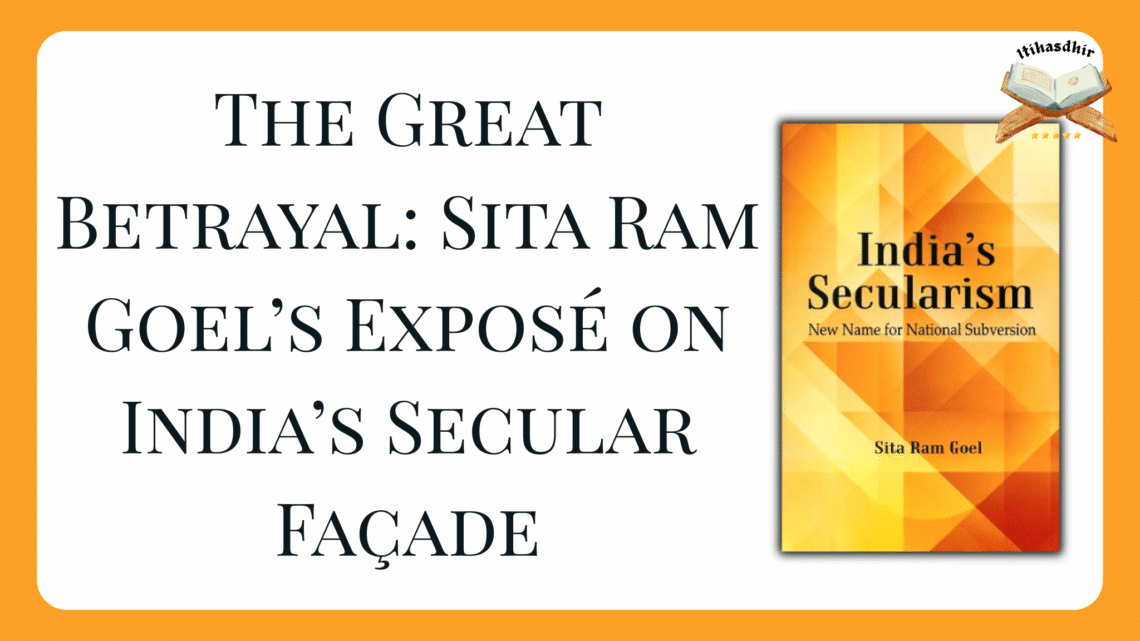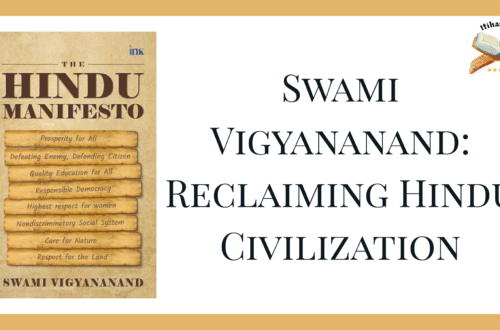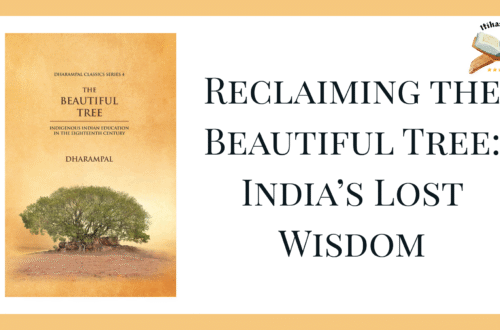
The Great Betrayal: Sita Ram Goel’s Exposé on India’s Secular Façade
In the grand theatre of post-independence Indian political discourse, few words enjoy as much sanctity, and as much ambiguity, as “secularism.” Brandished as a talisman of modernity, inclusivity, and national unity, secularism occupies an untouchable moral space in the republic’s ideological architecture. But what if this sacred principle has been, in practice, a mask for majoritarian disempowerment, a conduit for civilizational erasure, and a lever for political duplicity?
This is the argument, indeed, the warning, laid out with clinical precision and moral courage by the late Sita Ram Goel in his seminal work, India’s Secularism: New Name for National Subversion. First published in 1993, the book remains as urgent today as it was three decades ago. Perhaps even more so.
Goel, a publisher, historian, and civilizational thinker par excellence, does not simply offer a critique of Indian secularism, he demolishes its moral façade, exposing it as a construct designed to delegitimize Hindu civilizational continuity while enabling the unimpeded assertion of Islam and Christianity through state complicity and ideological sleight of hand.
Imported Secularism, Indigenous Damage
Goel begins with a foundational distinction. Western secularism, he reminds us, was born out of the trauma of religious monopoly, particularly that of the Church over the European state. It sought to restrain theocratic overreach. In India, however, no such monopoly ever existed. Dharma was never Church. Plurality was never imposed, it was organic.
Yet, post-independence India adopted a Western secular template, not as a philosophical framework suited to its unique civilizational fabric, but as a moral instrument to constrain the Hindu majority. In doing so, Goel argues, the Indian state mutated secularism into a weapon of asymmetric application.
Hindus were expected to be post-religious, eternally accommodative, and detached from their institutions. Meanwhile, religious minorities were encouraged, through law, policy, and discourse, to organize, assert, and evangelize.
The Structural Asymmetry
Goel systematically unpacks the institutional biases baked into India’s constitutional and administrative machinery. He points to Articles 29 and 30, which offer minorities exclusive rights to conserve their culture and manage their educational institutions. No equivalent provisions exist for the Hindu majority.
Even more disturbingly, the management of Hindu temples falls under direct state control, something unimaginable for churches or mosques. Temple revenues are routinely diverted to secular or even explicitly anti-Hindu causes. Priests are appointed by government authorities. Rituals and festivals are subjected to bureaucratic oversight.
This is not neutrality. It is state-sponsored religious apartheid, wrapped in the rhetoric of inclusivity.
A Three-Headed Hydra: Marxism, Islamism, Evangelism
At the heart of Goel’s thesis is his analysis of what he calls an ideological nexus: the unspoken, but potent, alliance between Marxist intellectuals, Islamic clericalism, and Christian missionary networks. These three forces, while often ideologically distinct, converge in one critical aim, the delegitimization of Hindu civilizational expression.
The Marxist suppresses dharma under the pretext of class struggle.
The Islamist invokes past victimhood to entrench present privileges.
The missionary deploys philanthropy and education to facilitate cultural conquest.
And all three operate with impunity, thanks to a state that punishes Hindu assertion but protects religious expansionism in the name of secularism.
Narrative as Sabotage: The Historical Battle
Goel devotes particular attention to the distortion of history in textbooks, academia, and media. He meticulously catalogs how Islamic invasions are sanitized as “cultural exchanges,” how the systematic destruction of temples is ignored or rationalized, and how Hindu resistance is rebranded as fanaticism.
This isn’t just a failure of historiography, it’s a form of civilizational amnesia being cultivated as state policy. In Goel’s words, the Hindu child is taught not just to forget his ancestors, but to feel ashamed of them.
Tolerance Turned Against Itself
The most philosophically incisive part of Goel’s argument lies in his dissection of Hindu tolerance. Dharma, unlike Abrahamic frameworks, is non-proselytizing, pluralistic, and intrinsically inclusive. But in the twisted logic of Indian secularism, this very tolerance is turned into a tool of suppression.
“When tolerance becomes unilateral,” Goel writes, “it ceases to be a virtue and becomes suicide.”
The Hindu is told he must be secular, but no such obligation exists for others. He must not organize politically, must not defend culturally, and must not assert civilizationally. All in the name of harmony. A harmony based on his silence.
Prophetic Relevance in the Present Day
Reading Goel today is an unsettling experience, because every one of his warnings has materialized:
- The temple autonomy debate remains unresolved.
- Waqf Boards now control vast swathes of land with little accountability.
- Missionary activity has intensified, fueled by global funding and aided by state inertia.
- Educational institutions remain captive to Marxist historiography.
- And Hindu assertion, when it emerges, is met not with empathy, but with hostility.
Goel saw it all. And he said so with brutal honesty, long before it was fashionable or even safe to do so.
A Wake-Up Call, Not a Whine
India’s Secularism: New Name for National Subversion is not a lament. It is a clarion call. A document that exposes the structural and ideological sabotage embedded in the modern Indian state, and dares to ask the one question secular India fears most:
Can a civilization survive if it is forbidden from defending itself?
Sita Ram Goel doesn’t offer easy answers. What he offers is clarity, the kind that comes not from anger, but from deep study, historical awareness, and a soul anchored in dharma.
In an age of ideological confusion and civilizational amnesia, this book stands as both a mirror and a manifesto. It demands to be read, not just by Hindus, but by all who wish to understand the true cost of ideological falsehood masquerading as national virtues.

Aditi Joshi founded Itihasdhir in 2023. She facilitates discussions on Indian history and the influence of historians. Currently, Aditi is a contributor of the VHPA initiative Stop HinduDvesha and serves as an Editor at Garuda Prakashan. A history graduate and folklore enthusiast, she is also an artist and translator, blending creativity and research to illuminate India’s cultural richness.





